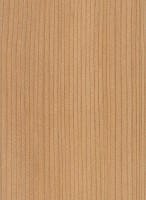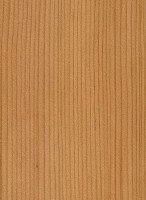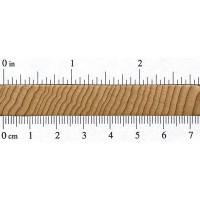 |
Common Name(s): Incense Cedar, California White Cedar Scientific Name: Calocedrus decurrens (syn. Libocedrus decurrens) Distribution: Western North America (primarily California) Tree Size: 65-100 ft (20-30 m) tall, 3-5 ft (1-1.5 m) trunk diameter Average Dried Weight: 24 lbs/ft3 (385 kg/m3) Specific Gravity (Basic, 12% MC): .35, .38 Janka Hardness: 470 lbf (2,090 N) Modulus of Rupture: 8,000 lbf/in2 (55.2 MPa) Elastic Modulus: 1,040,000 lbf/in2 (7.17 GPa) Crushing Strength: 5,200 lbf/in2 (35.9 MPa) Shrinkage: Radial: 3.3%, Tangential: 5.2%, Volumetric: 7.7%, T/R Ratio: 1.6 |
Color/Appearance: Heartwood is light to medium reddish brown. Sapwood is differentiated from heartwood and is light tan to off-white. It’s not uncommon for boards to contain pockets of partially decayed wood (peck) due to fungal attack.
Grain/Texture: Grain is straight, with a medium to fine uniform texture.
Endgrain: Resin canals absent; earlywood to latewood transition gradual, color contrast medium; tracheid diameter medium; zonate parenchyma.
Rot Resistance: Despite the commonness of pockets of fungal decay (sometimes referred to as “pecky cedar”), dried wood is rated as durable to very durable in regards to decay resistance, and the wood is sometimes used for fence posts on account of its good weathering characteristics.
Workability: Easy to work with both hand and machine tools. Holds paint very well. Stains, glues, and finishes well. Excellent dimensional stability.
Odor: Incense Cedar is one of the primary woods used in making pencils, and has a spicy odor that’s commonly associated with pencils.
Allergies/Toxicity: Although severe reactions are quite uncommon, Incense Cedar has been reported to cause skin irritation. See the articles Wood Allergies and Toxicity and Wood Dust Safety for more information.
Pricing/Availability: Prices likely to be moderate for a domestic species.
Sustainability: This wood species is not listed in the CITES Appendices, and is reported by the IUCN as being a species of least concern.
Common Uses: Pencils, Venetian blinds, fence posts, construction lumber, sheathing, siding, chests, and various exterior furniture applications.
Comments: Incense Cedar is favored for use in wood pencils due to its softness and ease of cutting without any splintering. (Historically, Eastern Redcedar was used for pencils, but limited supplies of the wood—and consequently higher prices—have caused it to become displaced by Incense Cedar in modern times.)
None available.
None available.
 |
 |
 |
 |





I’ve purchased a few boards from Home Depot and they list the dog eared cedar boards as “incense cedar” NOT red cedar although they do sell packs of red cedar for lining closets. The incense cedar boards are more whiteish in color. That is in California stores, can’t say what they have in other areas and incense cedar is common here and inexpensive at HD.
Home Depot current online catalog lists both Incense Cedar and Red Cedar in fencing products.
I’ve been having increasing asthmatic reactions to working with Incense Cedar (assuming that is what Home Depot actually uses in their fence pickets).
Everything I’ve seen at Home Depot appears to be Western Red Cedar, at where I’m located in the midwest.
You are correct EJM, Incense cedar does not have anywhere near the production capacity to attend to the needs of major retailers such as Lowes or HD. Their fencing products are Western Red Cedar and treated pine. WRC pickets come almost exclusively from interior U.S. and some coastal second growth which has a much lighter appearance in the heartwood and has more sapwood in the product which can sometimes be confused with the incense cedar.
For what it’s worth, the Lowe’s “chat” service claims that their cedar boards are incense cedar.
Sierra Pacific supplies a large amount of Incense Cedar to the big box stores, especially in CA
I got really bad asthma from having several logs in the house. This cedar can affect lungs as well as skin.